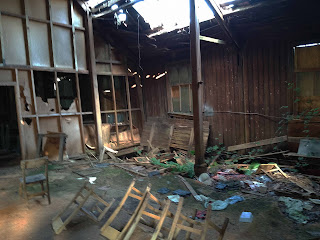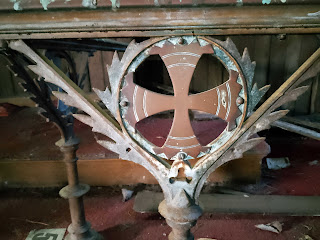Perched above the scenic Hollingworth Lake in the semi-rural town of Littleborough, Rochdale, St Hilda's CE Mission stood as a beacon of community spirit for nearly seven decades. envisioned a place of worship for the growing community of Hollingworth Fold. The decision to construct a church using corrugated iron and wood was driven by the need for a cost-effective and expedient solution, allowing the mission to be established promptly and serve the community's spiritual needs.The roots of St Hilda's CE Mission trace back to the 1870s, when a group of devoted individuals envisioned a place of worship for the growing community of Hollingworth Fold. This is a place that has been 'frozen in time'
I revisited the church along with Hong Kong based urban explorer Sacha Yasumoto in June 2023
hese fascinating, eerie pictures show how an abandoned church in Rochdale has been ‘frozen in time’ for almost 20 years.
It became known as the ‘Iron Church’ as it was made of metal sheets. It was later bought by the Mission of St Hilda, dismantled and re-built at Hollingworth Fold in 1931, until it was closed due to structural problems.Initial Board Members: James Edwin Haworth, who lived at 29 Lakebank in Littleborough, Fred Fielding, who lived at 13 Hollingworth Fold in Littleborough, and Samuel Moss, who lived at 107 Hollingworth Road in Littleborough, were the property's initial trustees. However, the conveyance was not completed before the deaths of two trustees: Rhodes Haworth of 109 Hollingworth Road and William Haworth of Gilliand Farm, Rakewood
The prominent "Iron Church" known as St. Hilda's Mission C of E, which used to serve St. Mary's RC Parish and was in Featherstall, Littleborough, is of particular interest at Hollingworth Fold. Using funds from the Hill Charity, the building, which was built with metal sheets, was sold to Hollingworth through the Mother church at Milnrow. It was rebuilt with structural changes in 1931 at its current location. Thanks to the efforts of a dedicated group of locals, the building is now used as both a meeting room and a church. Cannon Raines, who was born in Whitby and whose grandfather was the vicar of St. Hilda's church on the Hill, suggested the name St. Hilda. As a result, the church on the hill at Hollingworth was given the name because it was thought to be appropriate. The Source: A.W. Colligan JP's "The Weighver's Seaport - The Story of Hollingworth Lake," page 32.)
The church was purchased by St. Mary's RC Church for £6000. The Mission of St. Hilda's (CofE) purchased the Old Iron church of St. Mary's in June 1930 and reassembled it at Hollingworth Fold. John Hall was the head of the main family in the area, and the money from his estate was used to build schools in Ogden and Hollingworth. The old Catholic Church was purchased with this money now. The church was split in two in 1975, with one section serving as a church and the other as a place to meet under the care of the Milnrow Parish Church minister. The Source: John Street wrote "History of Littleborough," which came out in 1999.)
A recent inspection revealed structural issues that necessitated the church's closure. Monthly services have been temporarily suspended because the church was not a traditional parish church and only occasionally held services there. "It's not a parish church as such, and services were only held there from time to time," Reverend Usher stated. Source: Rochdale Observer, January 4, 1986) Mr. Clifford Ogden retired from his position as choir master at the mission church on Hollingworth Road on January 4, 1986. Source: The church was dedicated on October 17, 1931, by Archdeacon Sale (Rochdale Observer, 4/1/1986). Source: Observer of Rochdale, November 5, 2003)
Original visit in 2013

























































Great‼️
ReplyDelete